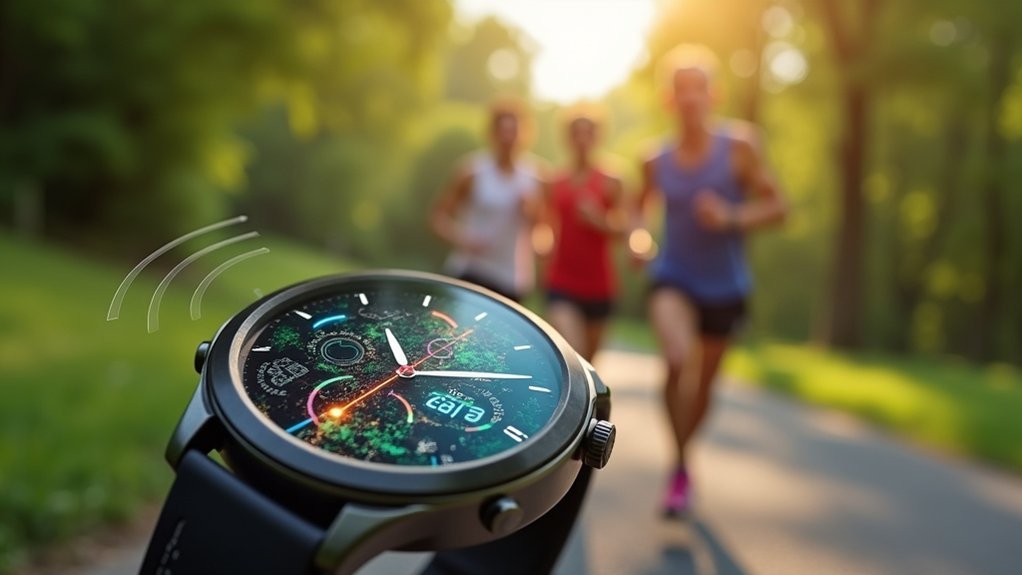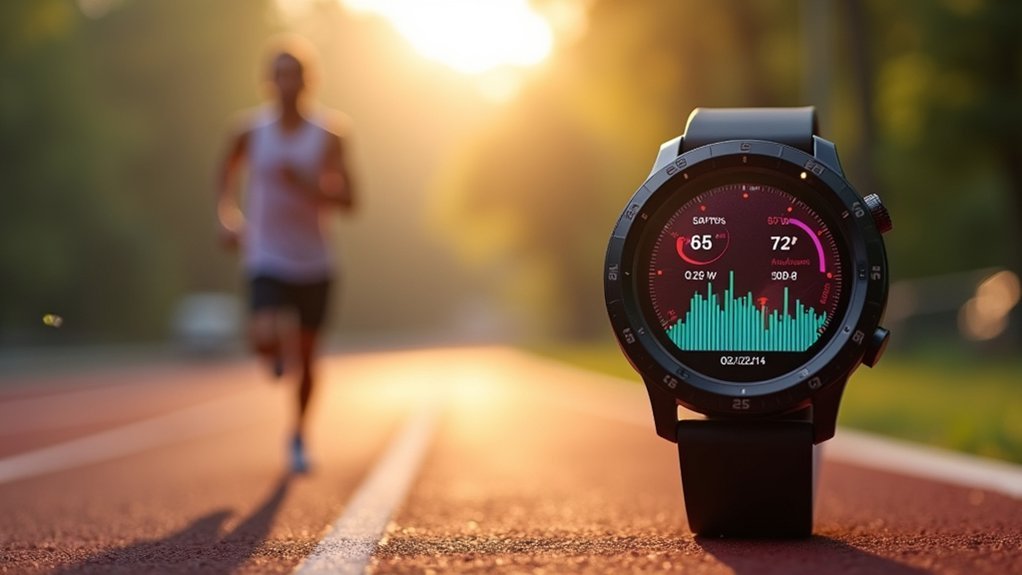Tracking your marathon data with watches offers essential insights beyond basic distance measurement. You’ll optimize race strategy with GPS precision, identify injury risks before they happen, and transform metrics into personalized training goals. Modern watches monitor whole-body health indicators, analyze running form, and visualize progress to build consistency. Historical data helps you make real-time race day adjustments that match your training capacity. The technology revolution in marathon training might surprise even seasoned runners.
Harnessing GPS Precision for Strategic Course Plotting

While marathon runners once relied solely on mile markers and intuition to navigate courses, today’s GPS watches have revolutionized how athletes approach race strategy.
You can now plot ideal racing lines and identify the shortest path through turns and corners, avoiding unnecessary extra distance.
Your watch records waypoints that serve as significant reference points, allowing you to map efficient routes and analyze where you accumulated extra distance post-race.
Waypoints capture your journey’s critical moments, revealing efficiency gaps and distance deviations in your racing line.
By overlaying GPS data onto course maps, you’ll gain visual understanding of the route dynamics, especially at turns where inefficient paths cost precious seconds.
This technology enables you to plan training routes mimicking race conditions and make mid-race tactical decisions based on your position relative to course landmarks, helping you allocate energy strategically throughout your marathon.
Common GPS accuracy is only around ±25 feet, which is why your device might show a slightly different distance than the official course measurement.
Identifying Injury Risks Before They Sideline Your Training
Because marathon training demands sustained physical exertion, your watch serves as a critical early warning system for potential injuries. Your device tracks patterns that precede common running problems, with previous injuries being your strongest predictor of future issues. Advanced watches can also identify muscle imbalances that contribute significantly to overuse injuries during marathon training.
| Risk Factor | Watch Metrics | Preventive Action |
|---|---|---|
| Previous Injuries | Asymmetry, stride changes | Modify training load |
| Overtraining | Weekly mileage, HR variability | Schedule recovery days |
| Biomechanical Issues | Cadence, foot strike | Correct running form |
| Footwear Problems | Shoe mileage tracking | Replace worn shoes |
Transforming Running Metrics Into Personalized Performance Goals

Your running watch collects mountains of data that can transform your training when you translate metrics into personalized goals.
By analyzing your ground contact time, cadence, and vertical oscillation, you’ll identify specific areas where small improvements can yield significant performance gains. A lactate threshold measurement can help determine your optimal heart rate zones for different training purposes.
Setting concrete objectives based on these metrics—like increasing cadence by 5% or reducing vertical oscillation—creates a data-driven path to becoming a more efficient, faster marathon runner.
Metrics Drive Training Adaptations
Modern marathon training thrives on the systematic transformation of running metrics into personalized performance plans. Your watch data reveals precisely where adaptations occur—or don’t—throughout your training cycle.
By tracking your running economy via real-time VO₂ estimates and gait analytics, you’ll identify efficiency gaps that waste precious energy over 26.2 miles. Your cardiovascular adaptations become visible through threshold drift measurements and recovery HR patterns, showing when your heart has fully adapted to training loads.
Lactate management—critical for marathon pace maintenance—improves when you monitor threshold paces at 95-100% of your current LT during structured workouts. Setting specific goals for each training block creates clarity in your progress trajectory.
Meanwhile, biomechanical efficiency tracking through stride angles and ground contact time helps eliminate energy-draining movement patterns that compound over marathon distances.
These metrics don’t just collect data—they drive the specific adaptations that transform your running potential.
Data-Fueled Goal Setting
Once training adaptations become visible in your watch data, a powerful opportunity emerges: transforming those metrics into precise marathon goals. Your watch provides valuable insights that make goal-setting more scientific and less guesswork.
By analyzing pace patterns, historical performance, and training progress, you’ll set realistic yet challenging targets. Newer runners might aim for 6-8% improvements, while experienced marathoners can use benchmarks from similar courses to fine-tune expectations. Consider implementing a tiered goal approach that includes A, B, and C targets to accommodate race day variables.
Remember to account for external factors like weather, course topography, and your training status when establishing time goals. If you’ve experienced training gaps or injuries, adjust accordingly.
The continuous feedback from your watch lets you modify goals throughout your training cycle, preventing both overly ambitious targets and underestimating your potential.
Monitoring Whole-Body Health Alongside Running Progress
While traditional marathon training focused primarily on mileage and pace, today’s advanced running watches transform training by monitoring extensive health metrics beyond running performance alone.
Your watch tracks cardiovascular health through continuous heart rate monitoring and HRV measurements, potentially identifying concerning patterns before they become serious.
Sleep quality data integrates with your training load to inform recovery needs, while stress indicators help balance running demands with life stressors.
These devices enhance injury prevention by capturing biomechanical data alongside physiological markers, allowing you to modify training proactively. The comprehensive training load assessment system provides crucial insights into both acute and chronic stress on your body, helping prevent overtraining.
The hydration and energy balance tracking provides personalized recommendations for fluid intake and post-run replenishment.
Together, these extensive health insights create a more sustainable approach to marathon training that protects your long-term wellbeing while improving performance.
Leveraging Advanced Analytics to Perfect Your Running Form

Beyond understanding your overall health, the precise mechanics of how you run can make the difference between a personal record and an injury. Modern running watches equipped with AI technology and advanced sensors analyze your gait, providing personalized recommendations to correct posture and improve cadence. The integration of computer vision AI with biomechanics algorithms offers unprecedented accuracy in analyzing individual running technique.
| Analytics Tool | Key Benefit |
|---|---|
| Gait Analysis | Identifies inefficiencies in form |
| AI Coaching | Suggests personalized adjustments |
| Run Form Analytics | Compares your form to peers |
| Long-Term Tracking | Shows form improvements over time |
Building Consistency Through Visual Progress Tracking
Visual progress tracking transforms your scattered runs into a consistent training narrative you can actually see.
When your watch displays weekly mileage trends, pace improvements, and workout streaks, you’ll spot patterns that reveal the true story of your training journey.
These visual cues create a powerful accountability system that helps you maintain consistency when motivation wanes, showing exactly where you’ve been and clearly mapping where you’re headed. Setting measurable short-term goals becomes easier when you can instantly access your performance data.
Building Consistency Through Visual Progress Tracking
As marathon runners log miles day after day, the power of seeing their progress visually transforms abstract effort into concrete achievement. Your watch creates a clear representation of your training consistency, reinforcing positive behaviors essential for marathon preparation.
Visual cues like daily streaks motivate sustained effort by highlighting success patterns. When you glance at your tile-based or grid visualizations, you’ll immediately comprehend your progress without detailed analysis. Setting up personalized plans based on your fitness level and goals can significantly enhance the effectiveness of your visual tracking system.
Seeing consecutive workout days encourages you to maintain your routine rather than break the chain. These visual reminders provide accountability and encourage daily commitment.
As you establish tracking habits, you’re building a structured running routine critical for marathon readiness. Your consistency becomes a visible challenge, turning your training into an ingrained habit that carries you through to race day.
Progress at a Glance
Modern marathon watches transform complex training data into intuitive visual snapshots that let you comprehend your progress immediately.
You’ll see weekly mileage trends that prevent injury-causing spikes while identifying plateaus in your endurance development.
These devices visualize your pace zones, highlighting consistency gaps and quantifying race-pace readiness compared to previous training cycles.
Heart rate correlations map your effort zones, detect cardiac drift during long runs, and flag potential overtraining through elevated resting rates.
Your watch’s consistency metrics generate streak counters and missed session alerts while tracking rest frequency to prevent under-recovery. These digital tools allow you to document any aches and pains you experience, making it easier to monitor potential injuries before they become serious problems.
The longitudinal visualizations display performance trends across months with interactive graphs that reveal seasonal variations and predict race outcomes—all accessible on customizable dashboards that overlay multiple metrics on shared timelines.
Patterns Reveal Training Truth
Beneath the raw numbers of your marathon training data lies a rich tapestry of patterns that reveal your true training story.
When you consistently track your runs, you’ll discover there’s no single path to marathon success—your unique patterns emerge through regular documentation.
Your watch becomes a powerful pattern recognition tool, helping you identify when you’re making progress or when you need to adjust.
Case-Based Reasoning techniques can profile your running style and suggest personalized consistency tweaks.
By visualizing these patterns over time, you’ll spot performance gaps and make informed training adjustments. Data shows that a significant portion of runners are either under-training or overtraining, affecting their marathon performance potential.
The most valuable insight from data tracking is prefactual reasoning—using current patterns to predict future outcomes.
This helps you maintain consistent effort while avoiding the injury risks that come with training inconsistency.
Optimizing Race Day Strategy With Historical Training Data
The wealth of training data accumulated on your running watch represents more than just a log of completed workouts—it’s a strategic goldmine for race day success. By analyzing pace patterns from long runs, you’ll identify your ideal pacing strategy and avoid the common trap of starting too fast.
Your watch’s heart rate zones and performance metrics guide sustainable effort throughout the race while helping you adjust goals based on current fitness. Historical sweat rate data informs personalized hydration timing, while weather-related performance comparisons enable precise pace adjustments for race day conditions. The data helps you plan when to consume your 3 GU gels throughout the race for optimal energy levels.
This data even strengthens your mental game by highlighting stress points requiring visualization strategies and confirming goal viability through recent workout progression.
Your watch transforms race logistics too—helping you replicate successful warm-up protocols and meal timing for a stress-free marathon experience.
Frequently Asked Questions
How Long Do Running Watch Batteries Typically Last Between Charges?
Your running watch battery typically lasts 10-30 hours with GPS on. Basic models provide around 30 hours, while high-end ultrarunning watches can reach 120-150 hours using optimized settings or solar charging features.
Can Marathon Watches Work Accurately on Treadmills and Indoor Tracks?
Marathon watches work on treadmills but aren’t fully accurate since they use arm movements instead of GPS. You’ll get better results by calibrating your watch for treadmill use or adding a foot pod for improved tracking.
Do Weather Conditions Affect GPS Accuracy in Running Watches?
Yes, weather affects your GPS accuracy. Heavy rain and snow can degrade signals, while extreme cold reduces battery efficiency. Ice buildup on the antenna will obstruct reception. Update firmware and start in open spaces for better results.
Are Budget Running Watches Worth Buying for Marathon Training?
Yes, budget running watches are worth buying for marathon training. You’ll get accurate GPS tracking, heart rate monitoring, and workout suggestions at an affordable price—all the essentials you need without paying for premium features.
How Often Should You Upgrade Your Running Watch Technology?
You should upgrade your running watch every 2-4 years, depending on technological advancements, battery degradation, and your needs. Upgrade sooner if new features considerably enhance your training or if your current watch malfunctions.
In Summary
Your running watch isn’t just a timekeeper—it’s your personal coach, strategist, and health guardian. By tracking your marathon data, you’re not only recording miles but creating a blueprint for success. You’ll prevent injuries, set meaningful goals, and refine your technique with every run. When race day arrives, you’ll toe the starting line with confidence, armed with insights that transform raw effort into strategic performance.





Leave a Reply